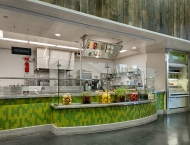Children's Discovery Museum FoodShed Cafe Provides Healthy Food and Education

September 16, 2015
For over 25 years, Children's Discovery Museum of San Jose (CDM) has been providing the highest quality educational experiences for children and their families. The museum continuously cultivates its interactive exhibits and programs to inspire creativity, curiosity, and lifelong learning. But one prominent area of the museum was not serving that mission - the café.
"It was really more like a snack bar at the ballpark," explains Marilee Jennings, CDM Executive Director. "Over the past few years we have focused a lot of attention to the issue of healthy, sustainable food, and creating and refining exhibits like our raised vegetable garden and our ‘Rainbow Market’ shopping activity. But our own food service facility wasn’t carrying out that theme."
Jennings and her staff were committed to creating an eating experience that would reflect Silicon Valley's own agricultural past and its current urban farming boom, engage kids in eating and enjoying healthy and local food, and would not be a drain on CDM's budget. “We don’t mind breaking even, but we had to figure out a business model that would prevent us from going broke providing the quality food we knew would reflect our mission."
Before the first zucchini could be sliced, the whole space required a radical upgrade. CDM's team for the redesign and construction included Amelia Vogelheim of San Francisco architecture firm Baldauf Catton Von Eckartsberg (BCV) and Toeniskoetter Construction.
Remodeling the existing café included refurbishing the seating area, kitchen, and storage area. The seating area required constructing two decorative walls, building a new service counter, putting in new furniture and fixtures, and installing ceiling-mounted sound baffles. In the kitchen and storage area, the construction included some electrical and plumbing work and installing new kitchen equipment.
Working closely with BCV, Toeniskoetter Construction sourced reclaimed barn wood salvaged from old farm buildings along the Pacific Coast. As a wall covering, these beautiful planks perfectly set the farm-to-table atmosphere, while reflecting Silicon Valley’s agricultural history and exemplifying sustainable building practices.
Since the cafe is located in the high-ceilinged central area of the museum, acoustics have always been an issue. Originally, the walls and ceilings of the area were covered with the sound-absorbing treatment Pyrok, which after 20 years was showing signs of wear and tear. Removing the Pyrok from the walls was a challenge, creating clouds of fine dust, especially a problem since much of the work had to be done while the museum was open to visitors. Toeniskoetter was able to keep the dust clouds under control and protect the work area from hundreds of curious little visitors.
Once the old Pyrok was removed, a new acoustical solution needed to be found. Wendy Weiden with Karp Resources worked with Sharon Sullivan at West General Acoustics and Environmental to make sound baffles reminiscent of pool noodles that would hang from the ceiling over the cafe. David Fenster and Andy Brandt of Modulus designed the sculptural layout and color scheme for the baffles. As Marilee Jennings noted, "I think this connection between acoustic science and aesthetic art is really at the heart of our mission at CDM."
The cafe’s new name, "FoodShed", is another multi-purpose part of the CDM's meticulous branding approach. A foodshed is like a watershed – it refers to a geographical area from which local food products are sourced. CDM's FoodShed has a wall map showing an 11-county area, from Sonoma to Salinas, literally the FoodShed's foodshed. Magnetic markers with icons can be repositioned seasonally to show where the FoodShed's produce, dairy products, baked goods and even coffee beans come from.
"We knew we needed a local contractor for this complicated renovation, a team that could be nimble, flexible and responsive," stated Jennings. “Toeniskoetter has been working with us on other upgrades throughout the museum, and they have been able to work within the constraints of a museum in full operation. They made major aesthetic contributions to the FoodShed with its barn wood, fixtures, tile work and sound sculpture. We really appreciated that they understood how tight a not-for-profit organization’s budget can be, and quickly came up with cost-savings suggestions. Finally, their on-site project superintendent became our "Bob the Builder' – a hit when he was problem-solving with our staff and when he was kindly and charmingly interacting with museum visitors."